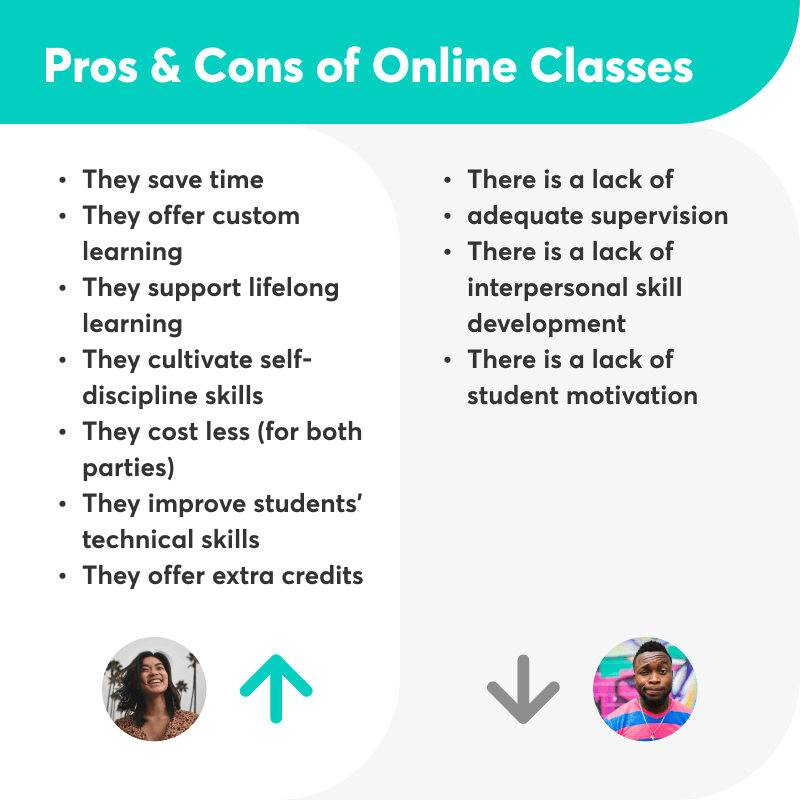Table of Contents
Since the emergence of online learning, there has been a discussion on whether online classes are better than traditional classes. At the moment many competing schools of thought are coming up with valid arguments for and against both.
At the same time, post-COVID-19 research data shows that elearning grows at a fast rate, proving that online instruction is here to stay. In the case of distance learning at least, online classes are clearly more appropriate for colleges and universities and the rise of online degrees proves this.
Distance learning allows students to balance their work-related and personal commitments more effectively. They believe that they get a high-quality education at their own pace and convenience, which is a fair point.
Nonetheless, both traditional and online learning comes with advantages and disadvantages. So, the real question here is when is online learning more convenient than traditional learning?
This article discusses the real potential of online vs traditional classes while analyzing both in more detail.
Let’s dive in!
Table of contents
Master the Art of Creating & Selling Online Courses
Join Course Masters and learn from leading experts as they share their secrets for creating, marketing & selling online courses destined for success.
Online learning (often referred to as e-learning or remote learning) is any form of education that takes place over the internet. Students attend online classes, study online courses, or get involved in real-time interactions with teachers and students at the other end with the help of various digital tools. Students go through the curriculum at their own pace and can access the class from anywhere easily.
Online learning is a reality and is gradually becoming part of formal education. This educational model appeals to anyone who cannot attend a physical faculty or school. Online learning climbs over the national boundaries and is offered to dispersed college students giving them the option to choose an online program of their preference.
But, how does online learning work?
Learning management systems (LMS) provide an accessible exchange of information between professors and students. This way, students can view learning material at their leisure or even attend scheduled conferences or lectures.
When it comes to learner assessments or online test-taking, learners can submit course assignments through the LMS, participate in any group discussion, or submit other tasks. Professors may also provide feedback back to students directly, through comments or emails.

Traditional education refers to the type of instruction that takes place in a classroom where both instructor and students are physically present. This traditional classroom-based setting requires students to attend classes in person and on campus of traditional educational institutions. It mostly appeals to learners who prefer face-to-face interaction or want to live the real college experience. Counselors and professors are available for additional assistance and guidance on campus.
In a traditional classroom, hands-on training during class can take place (e.g., in a laboratory) and students interact with fellow students directly while getting involved in many hands-on projects.
Depending on the class schedule, students attend two or three classes per week, either during the day or in the evenings.
While distance learning may be most appropriate at colleges and universities, this does not mean that it can replace traditional learning in all settings or that it is more effective than traditional learning. For example, early studies by Daymond and Blau (2008) and Yerby and Floyd (2013) showed that online students perform as well but not better than traditional students in a classroom environment.
Before we go into further analysis, here is a summary table of all online classes’ pros and cons.
| Pros | Cons |
|---|---|
| They save time | There is a lack of adequate supervision |
| They offer custom learning | There is a lack of interpersonal skill development |
| They support lifelong learning | There is a lack of student motivation |
| They cultivate self-discipline skills | |
| They cost less (for both parties) | |
| They improve students’ technical skills | |
| They offer extra credits |

They save time
Online classes save time for students because they give them the freedom to decide their own day-to-day schedule. Students can progress at their own pace and attend classes from their homes. They have the flexibility to set their everyday routine and cultivate a more personal learning experience. Also, a lot of time is saved on commuting.
They offer custom learning
Apart from flexibility in time, there is also flexibility in the studied material. Students in many cases can get tailored coursework according to their learning style or needs- this is especially true for undergraduate Virtual Schools. It is also worth mentioning that online courses offer shy students the opportunity to participate in class discussions more easily than face-to-face class sessions.
They support lifelong learning
Online learning can also prove essential to many adults. Some people never finished high school and want to get an actual diploma without having to step back into the classroom because they work full-time. Online learning offers a variety of options. No matter what students study, they can find the courses or programs they need online (from a career certificate to a doctorate).
They cultivate self-discipline skills
In a traditional classroom, it is easier for professors to evaluate students’ strengths and weaknesses and give guidance. Also, businesses now need great interpersonal skills to hire someone including proven communication, and teamwork. Traditional physical classrooms are better in terms of cultivating these essential interpersonal skills.
They have lower total costs
Research shows that distance higher education reduces costs due to specific factors:
Other factors are: Avoiding commuting costs, course material (like books) provided at no cost, housing near the university. Lastly, students can use the alternative of massive open online courses (MOOCs) to gain credits.
Lower costs come with more flexibility on the students’ side and allow previously undressed minorities to go to enroll in college.
They improve students’ technical skills
The participation skills students learn within their online courses translate to many professions, including creating and sharing documents, incorporating audio/video materials into assignments, completing online training sessions, etc. Some schools even offer students free laptops or iPads.
They offer extra credits
Students can earn college credit through online classes and transfer their credits to the college they are studying (e.g., during summer vacation).
There is a lack of adequate supervision
Online education requires that students hold a certain degree of self-discipline. For some students, the lack of supervision may amount to too much freedom, which may make them fall behind without anyone letting them know.
There is a lack of interpersonal skill development
Online courses sometimes may hinder interpersonal skills gained by students. In traditional classrooms, students are required to speak their minds and give presentations and speeches. They are also required to work face-to-face in groups with all kinds of people with many differing viewpoints. These procedures bring in very crucial interpersonal skills. However, online learning involves none of that.
There is a lack of student motivation
When students receive face-to-face teaching, they come across verbal feedback and constructive criticism, which instills in them a self-motivation not to want to let their teachers down.
This makes them more motivated to succeed in specific fields. In this regard, a sense of community is more essential in the online environment, and additional attention is needed to avoid failure.
Here is a summary table of all traditional classes’ pros and cons.
| Pros | Cons |
|---|---|
| Students learn to work under pressure | There are additional costs |
| They cultivate interpersonal skills | There are is no flexibility in study hours |
| Students gain more confidence in public speaking | There is a narrow variety of interactions |
| There is greater motivation | They are not suitable for introverted students |
| There are lab sessions |
Now let’s see in detail each one of them:
Students learn to work under pressure
In traditional classrooms, students learn more easily to work under the pressure of time. Besides, during their professional careers, they will need to complete tasks in a certain amount of time. Assigning in-class activities that need to be finished in a couple of hours, for example, prepares students for the professional world.
They cultivate interpersonal skills
In a traditional classroom, it is easier for professors to evaluate students’ strengths and weaknesses and give guidance. Also, businesses now need great interpersonal skills to hire someone including proven communication, and teamwork. Traditional physical classrooms are better in terms of cultivating these essential interpersonal skills.
Students gain more confidence in public speaking
Like the rest of interpersonal skills, confidence and ability to speak in public are only cultivated when students are required to interact with a live audience. Students learn how to carry themselves in a professional manner.
There is greater motivation
Online learning may encourage procrastination. Interpersonal communication sometimes is crucial to keep students engaged and fully satisfied with the learning experience. Also, on-campus offers more opportunities like these:
There are lab sessions
Most degrees require lab hours. On-campus classes can provide a substitute for actual hands-on experience. Sometimes, employees prefer graduates from traditional institutions because they have extensive and relevant lab experience.
There are additional costs
The cost of online classes vs traditional classes is much less. Traditional education requires additional costs such as commuting to a faculty or college, accommodation fees, and class equipment.
There are is no flexibility in study hours
Because students have to physically attend classrooms, there is less free time left in pursuing other tasks. Therefore, they have to organize their daily tasks based on class attendance.
There is a narrow variety of interactions
In traditional classrooms, social interactions are limited to local people. Their knowledge base is limited because unlike online education, they do not have access to people from other countries to acquire a global perspective.
They are not suitable for introverted students
In a traditional classroom setting, students feel more pressured when they have to orally answer specific questions, or infer a conclusion. On the other hand, an online classroom allows students to feel more comfortable and express their critical thinking more freely.
When asked to compare and contrast virtual vs real classrooms, there is no one easy answer. However, it’s true – education has changed dramatically over the last years, with the distinctive rise of e-learning due to the COVID-19 pandemic and schools having to shut down all across the world.
The pandemic taught us that schools and faculties must be ready at all times to go online and teach remotely making use of digital platforms. The changes that coronavirus has brought might be here to stay.
Starting an online school is a piece of cake. With the plethora of online learning platforms and learning management systems – LMSs, out there, today it’s easy to start your own online school. Using a state-of-the-art online learning platform like LearnWorlds ensures that you are offering all the social and learning features to provide learning that is equal – if not superior, to traditional learning.
On top of what is already covered here, the workload that has to be completed by students remains similar between traditional and online education. In either format, there are exams, papers, presentations, and projects. Each of these activities may come with a deadline that learners must meet while weekly readings and course lectures surface in both delivery methods.
However, each choice is more suitable for specific instances. Traditional education might be the best for someone who wants the whole social classroom experience. To enjoy a more flexible option though, online education may be more beneficial.
Both online and traditional education have their perks. So, it seems like there is a need to get the best of both worlds.
“Blended learning” is a new type of learning that is becoming increasingly popular. In blended learning environments, students experience a combination of online tutoring as well as offline, face-to-face interactions.
What’s the take here?
Both online and traditional have their place and depending on the situation, one might be better suited than the other. Whether you are deciding which one is best, you will need to think of it in a case-by-case scenario.
What would be the best way to reach your students?
What costs might be involved with each?
Is this the best way of teaching the subject and interacting with the students?
While you are deciding on how to teach, you might want to consider one or the other or a blended approach of the two. Either way, you should always try to make the best out of each method for your learners.
So, what would it be? Reach out and let us know!
Master the Art of Creating & Selling Online Courses
Join Course Masters and learn from leading experts as they share their secrets for creating, marketing & selling online courses destined for success.
Is online schooling as effective as in-class education?
Online tuition can be as effective as in-class education provided that you use the right tools that allow you to create an environment that fosters learning and student participation. With LearnWorlds you have everything you need to start your own school and build an online community of learners.
Why is in-person learning better than online?
Learning that happens in a traditional classroom allows students to work together face-to-face. It’s more direct, it helps students develop interpersonal skills that are vital later in life. Working as part of a group in a physical setting also boosts their overall confidence and motivation to achieve more.
Is online college better than in-person?
Taking an online course or being a student at an online college has its benefits. This includes lower tuition fees, flexible studying and/or working times, and spending less time and money on commuting. Whether it’s better than in-person classes depends on the requirements of each individual.
What are the advantages and disadvantages of independent learning?
Independent learning has the following advantages:
– Learner’s differences are easier to spot
– Learners can study at their own pace
– It makes use of a variety of learning styles
– It is cost-effective and appropriate for a large number of learners
– Learners are more in control of what they learn and in what way(s)
Independent learning has the following disadvantages:
– It takes more time to prepare the appropriate materials
– It is difficult to maintain learners’ motivation
– The instructor needs to change roles constantly
What are the advantages and disadvantages of modern teaching methods?
These are the advantages of modern teaching methods:
– Develop students’ cognitive thinking skills
– Promote students’ self-learning and discovery of interests
– Create unique and tailored-made patterns of learning
– Focus on the applicability of skills
– Build on students’ competence to face changing environments
These are the disadvantages of modern teaching methods:
– Less interaction and a weaker bond between the instructor and the students
– Students’ self-discipline is hard to maintain
– Technical knowledge is often required to access them
– Can be more expensive compared to traditional teaching methods
Further reading you might find interesting:
Kyriaki is the SEO Content Manager at LearnWorlds, where she writes and edits content about marketing and e-learning, helping course creators build, market, and sell successful online courses. With a degree in Career Guidance and a solid background in education management and career development, she combines strategic insight with a passion for lifelong learning. Outside of work, she enjoys expressing her creativity through music.



